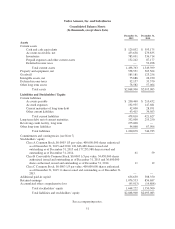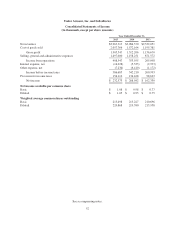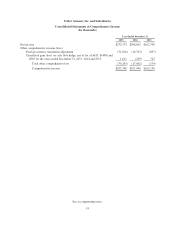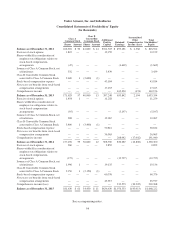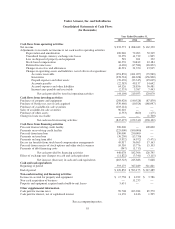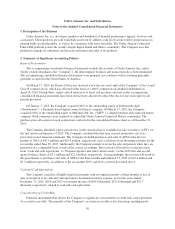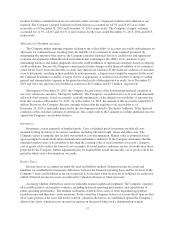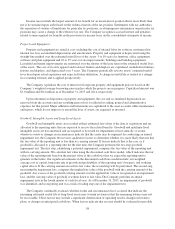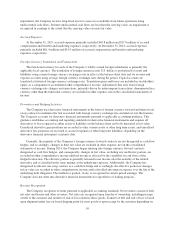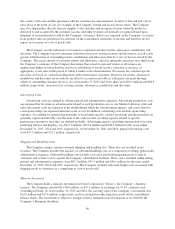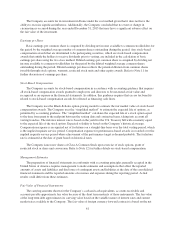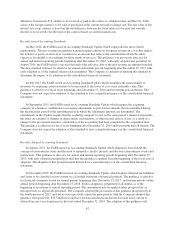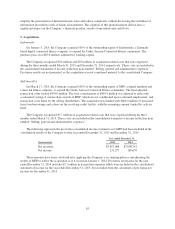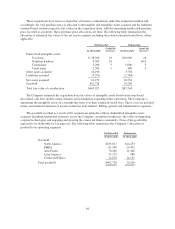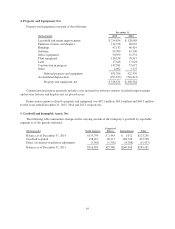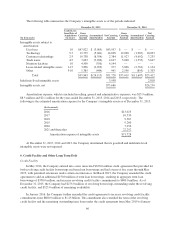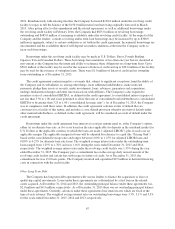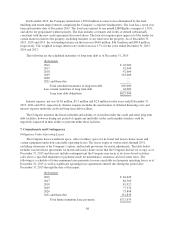Under Armour 2015 Annual Report Download - page 69
Download and view the complete annual report
Please find page 69 of the 2015 Under Armour annual report below. You can navigate through the pages in the report by either clicking on the pages listed below, or by using the keyword search tool below to find specific information within the annual report.The Company accounts for its investment in Dome under the cost method given that it does not have the
ability to exercise significant influence. Additionally, the Company concluded that no event or change in
circumstances occurred during the year ended December 31, 2015 that may have a significant adverse effect on
the fair value of the investment.
Earnings per Share
Basic earnings per common share is computed by dividing net income available to common stockholders for
the period by the weighted average number of common shares outstanding during the period. Any stock-based
compensation awards that are determined to be participating securities, which are stock-based compensation
awards that entitle the holders to receive dividends prior to vesting, are included in the calculation of basic
earnings per share using the two class method. Diluted earnings per common share is computed by dividing net
income available to common stockholders for the period by the diluted weighted average common shares
outstanding during the period. Diluted earnings per share reflects the potential dilution from common shares
issuable through stock options, warrants, restricted stock units and other equity awards. Refer to Note 11 for
further discussion of earnings per share.
Stock-Based Compensation
The Company accounts for stock-based compensation in accordance with accounting guidance that requires
all stock-based compensation awards granted to employees and directors to be measured at fair value and
recognized as an expense in the financial statements. In addition, this guidance requires that excess tax benefits
related to stock-based compensation awards be reflected as financing cash flows.
The Company uses the Black-Scholes option-pricing model to estimate the fair market value of stock-based
compensation awards. The Company uses the “simplified method” to estimate the expected life of options, as
permitted by accounting guidance. The “simplified method” calculates the expected life of a stock option equal
to the time from grant to the midpoint between the vesting date and contractual term, taking into account all
vesting tranches. The risk free interest rate is based on the yield for the U.S. Treasury bill with a maturity equal
to the expected life of the stock option. Expected volatility is based on the Company’s historical average.
Compensation expense is recognized net of forfeitures on a straight-line basis over the total vesting period, which
is the implied requisite service period. Compensation expense for performance-based awards is recorded over the
implied requisite service period when achievement of the performance target is deemed probable. The forfeiture
rate is estimated at the date of grant based on historical rates.
The Company issues new shares of Class A Common Stock upon exercise of stock options, grant of
restricted stock or share unit conversion. Refer to Note 12 for further details on stock-based compensation.
Management Estimates
The preparation of financial statements in conformity with accounting principles generally accepted in the
United States of America requires management to make estimates and assumptions that affect the reported
amounts of assets and liabilities and disclosure of contingent assets and liabilities at the date of the consolidated
financial statements and the reported amounts of revenues and expenses during the reporting period. Actual
results could differ from these estimates.
Fair Value of Financial Instruments
The carrying amounts shown for the Company’s cash and cash equivalents, accounts receivable and
accounts payable approximate fair value because of the short term maturity of those instruments. The fair value
of the long term debt approximates its carrying value based on the variable nature of interest rates and current
market rates available to the Company. The fair value of foreign currency forward contracts is based on the net
61


